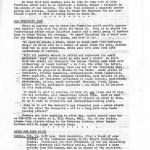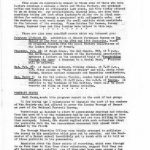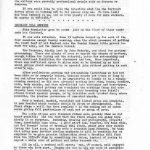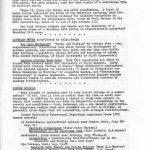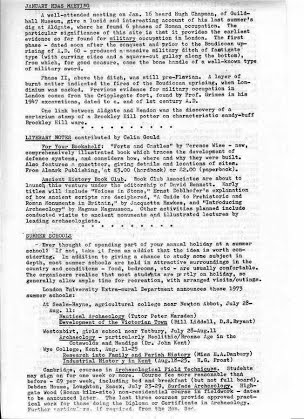
Page 1
Star news item this month is the Reception-cum-Lecture which the Society is planning for the Mayor and Mayoress of Barnet, Alderman and Mrs. J. L. Freedman, on Saturday 31st March in the Cavalier suite of the Prince Albert, Golders Green Road, NW11.
We hope that many members will be able to take part in his function of, which will be important – indeed, unique – in the annals of our Society. you will find enclosed a separate letter giving all details. Please help to thank the Mayoress for her continued support of HADAS by coming along on March 31st.
Old Curiosity Shop
There is another way in which the committee would greatly appreciate members’ help with the plans for March 31st. This is to assist the fund-of raising effort which Christine Arnott and a small group of members hope to stage during the evening. We asked Christina for a brief note for the newsletter about her plans, and here it is:
“We want to create a stall, which we shall call “Old Curiosity Shop”, on which will be a number of small items for sale, second-hand but in good condition, which will have some link with archaeology or history.
Will all members search in attics and cupboards for small potential buys which could go on to such a stall? We don’t mind how widely you interpret the phrase “having some link with archaeology or local history” – in fact, the wider the better. Just to start you thinking, have you any of the following that you would be prepared to donate to the stall: small pieces of jewellery, holiday mementoes, archaeological finds (annotated, where possible, in true academic tradition, with details of provenance), any documents pertaining to local history, postcards, photographs, prints, small pictures? Pottery, china, glass, silver, shells, geological specimens – all might be of interest in this connection.
We shall be glad to receive, or hear of, any items and if they are not suitable, will immediately return them. What we want is a wide range and a large number of objects on which to draw, so as to make an attractive and interesting looking stall.
Help us to get to the society’s new financial year — which starts day after the Reception — off to a good start with this fund-raising effort.”
Members who have anything to offer Mrs. Arnott should ring or write to her. Or, if you prefer, please take objects to the February lecture, where Daphne Lorimer will be happy to receive them.
Dates for your diary
Sunday Feb 11
Work re-starts, after a break of some months, on the tombstone survey in St. Mary’s Churchyard, Hendon. Volunteers for that afternoon, or for any succeeding Sunday afternoon until further notice, will receive a warm welcome from Ted Sammes, who is in charge of the operation. No need to say you are coming – just turn up. No previous experience necessary, either, so this is a golden opportunity for new members who have not previously helped with any of the Society’s projects.
Tuesday Feb 20
Next HADAS lecture will be by R. J. Mercer, on his dig last summer at Carn Brae, Redruth, Cornwall. This was a total excavation of a Neolithic settlement site – a lean-to structure built against a massive stone wall which still surrounds the whole Neolithic settlement area. A stone hut circle of Iron Age date was also excavated, as was a rampart gateway. Prehistorian members should be in their element.
Page 2
Tuesday March 20
Dennis Hazelgrove on the Fulham Potteries.
Tuesday April 10
Dr. Wallis of the British Museum Map Room.
Last month’s experiment of starting Society evenings at 8.00 p.m. with half an hour’s coffee and chat seemed to be enjoyed by all, and we propose to make it permanent – so come along to the hall at 8 p.m.
This seems to be an appropriate moment to thank some of those who make Lecture evenings a success – Carol and Elaine Norbury, who produced coffee and biscuits so efficiently last month, and have kindly offered to go on doing so; our projectionist, Raymond Lowe, who does this sometimes tricky job (not every lecturer’s slides are in ideal condition for putting through a projector) and unflappable calm; and the members who each month mount the small exhibits which contribute to the interest of the evening. Since October, Ted Sammes, Jeremy Clynes, Raymond Lowe and Alec Jeakins have helped in this way.
Other events
There are also some non-HADAS events which may be of interest to you:
February 17-March 25:
Exhibition at Church Farm House Museum on “The relief of the poor in the 18th and 19th centuries, based on original records from the Local History Collections of the London Borough of Barnet.
Thursday Feb 22
At Burgh House, New End Square, NW3, at 8 p.m., the North West London branch of the Historical Association sponsors a lecture on the unexpected topic of “Pawnbroking through the ages: a response to a Social Need”. Visitors will be welcome.
Wednesday Feb 28
At Burnt Oak Library, Watling Avenue, at 8.15 p.m., C. M. Dixon speaks on “Views of Greece” and will, among other things, discuss ancient monuments and Byzantine architecture.
Saturday March 3
In the Old Lecture Theatre, London School of Economics, Houghton Street, WC2 at 2.15 p.m., the A.G.M. of RESCUE. In addition to the business of the meeting, there will be short reports and films on four Rescue projects.
Portrait Survey
Nell Penny sends this progress report on the work of her group:
“A few months ago, I volunteered to organise the work of ten members of the Society who had offered to cover the London Borough of Barnet as part of the National Portrait Survey.
Tentatively, we decided to start by approaching churches and schools. From the work of 4 of the volunteers and my own investigations, we have found out that churches do have portraits and are very willing to have them surveyed. Indeed, one church replied with such enthusiasm about its portraits that the two researchers concerned felt almost overwhelmed by the flood!
The Borough Education Officer very kindly arranged to publicise the survey in his newsletter which goes out to all schools; and the Headmaster of a Barnet school immediately got in touch with us to tell us of three portraits in his possession.
Enquiries about the finer points of recording, which come through to me from time to time from other volunteers, suggest that they are beavering away quietly; one of them must have come across a few miniatures, since she suddenly needed a stock of the special small stickers which are put onto the backs of miniatures after recording. (Every portrait recorded has a sticker fixed to the back, so that in future years, no one will cover the same ground.
For my own part, idle chatter with a friend resulted in an introduction to her mother who has several portraits. These will keep me busy for some time, largely because my knowledge of portrait media is so limited.
Page 3
Two small family portraits in my own house reminded me of the saying that the cobblers children are always the worst shod – so off I went to the National Portrait Gallery, where on Wednesdays and Fridays between 2.30-4.30 the Keeper on duty will discuss the provenance of portraits brought in by members of the public for inspection. No appointments need to be made, and there is no charge for this service. The Keeper will not give any valuation, but he will tell you all he can about the portrait. Mine were firmly dated between 1830-1840; I was told they were of provincial rather than London origin and that the sitters were probably professional people such as doctors or lawyers.
If you would like to join the detective club (as the Portrait Survey Group is turning out to be), please ring me. No time limit has been imposed on us, and we have plenty of room for more workers.”
Brockley Hill Weekend
This newsletter goes to press just as the first of these weekends has finished.
It was well attended. Some 15 members turned up for each of the four sessions except Sunday morning, when the rival pressure of getting the roast beef of old England onto the Sunday dinner table proved too much for some and the numbers halved.
The Teahouse, kindly lent by John Enderby, was ideal for pottery processing. There was plenty of room to unpack chests of pottery, enough tables for laying out material. Water for pot washing and even civilised facilities for elevenses and tea. More important, there was sufficient space to allow work to be divided up so that small groups could concentrate on special jobs without getting in each other’s way.
After preliminary sorting and pot-washing (something we had not been able to do properly before, because coarse pot takes so long to dry out after washing that it is impractical to handle it in a single evening session), we did some more advanced sorting into rims, bases, handles, lids, body sherds, and then sub-divided into rim-types and base-types. Some people marked pottery and varnished the markings (none had previously been varnished, and some marks were very faint); others listed special groups, or by detective work tracked down, where possible, the precise provenance of unmarked sherds.
Once a washed, marked, varnished and listed group was complete, it was decided which vessels should be drawn and photographed. The final stage – still far from complete – is the making out of index cards giving full particulars of each pot or group of pots.
The early stage were finished rather more quickly than we had possibly hoped; and the fact that the final stages are going more slowly is no surprise. Indexing, drawing and photography, properly done, inevitably take time. A good start has, however, now been made, and Ted Sammes’ index of Brockley Hill finds, which grew only slowly during the last year, has now made a dramatic leap forward. We hope that after some further similar weekends it will be possible for an enquirer to be given precise information about a Brockley Hill find from the 1937-54 digs by consulting the index, instead of having to unpack a whole case of pottery and later re-pack it.
All in all, a weekend well spent; and, it seemed, well enjoyed by those who took part. Thanks are due to all who made it possible: first and foremost, to John Enderby and the HGS Institute; to Jeremy Clynes, Ann Trewick and Brigid Grafton Green, who “laid out” the night before in order to get off to a flying start; and to all members who turned up and worked with a will. One helper even came all the way from Woking because she had a special interest in Brockley Hill. She has now decided to join HADAS as an “out of town” member.
Incidentally, we are desperately short of members with skill in drawing. Will anyone with a drawing ability and a yen to try his/her hand on Roman pot. Please get in touch with Brigid Grafton Green.
Page 4
January HADAS meeting
A well-attended meeting on Jan. 16 heard Hugh Chapman, of Guildhall Museum, give a lucid and interesting account of his last summer’s dig at Aldgate, where he found 6 phases of Roman occupation. The particular significance of this site is that it provides the earliest evidence so far found for military occupation in London. The first phase – dated soon after the conquest and prior to the Boudiccan uprising of AD 60 – produced a massive military ditch of fastigate type (with curving sides and a square-cut gulley along the bottom), from which, for good measure, came the bone handle of a well-known type of military sword.
Phase 2, above the ditch, was still pre-Flavian. A layer of burnt matter indicated the fires of the Boudiccan uprising, when Londinium was sacked. Previous evidence for military occupation in London comes from the Cripplegate Fort, found by Professor Grimes in his 1947 excavations, dated to c. end of 1st century A.D.
One link between Aldgate and Hendon was the discovery of a mortarium stamp of a Brockley Hill potter on characteristic sandy-buff Brockley Hill ware.
Literary Notes – contributed by Celia Gould
For your bookshelf : –
“Forts and Castles“ by Terence Wise – new, comprehensively illustrated book which traces the development of defence systems, and considers how, where and why they were built. Also features a gazetteer, giving details and locations of sites. From Almark Publishing, at £3.00 (hardback) or £2 (paperback).
Ancient History Book Club. Book Club Associates are about to launch this venture under the editorship of David Bennett. Early titles will include “Voices in Stone”, Ernst Doblhofer’s explanation of how ancient scripts were deciphered, “A guide to Prehistoric and Roman Monuments in Britain”, by Jacqetta Hawkes, and “Introducing Archaeology” by Magnus Magnusson, Other activities planned include conducted visits to ancient monuments and illustrated lectures by leading archaeologists.
Summer Schools
Ever though of spending part of your annual holiday at a summer school? If not, take it from an addict that the idea is worth considering. In addition to giving a chance to study some subject in depth, most summer schools are held in attractive surroundings in the country and conditions – food, bedrooms, etc. – are usually comfortable. The organisers realise that most students are partly on holiday, so generally allow ample time for recreation, with arranged visits/outings.
London University Extra-mural Department announces these 1973 summer schools:
At Seale-Hayne agricultural college near Newton Abbot, July 28-Aug 11:
– Nautical Archaeology (Tutor Peter Marsden)
– Development of the Victorian Town (Bill Liddell, D. S. Bryant)
Westonbirty girls school near Tetbury, July 28 – Aug 11
– Archaeology – particularly Neoliothic/Bronze Age in the Cotswolds and Mendips (Dr. John Kent)
Wye College, Kent, Aug. 11-25
– Research into Family and Parish history (Miss E. A. Danbury)
– Industrial History on Kent (H. G. Frost)
Cambridge, courses in Archaeological field techniques. Students may sign on for one week or more. Course fee more reasonable than before – £9 per week, including bed and breakfast (but not full board).
Debden House, Loughton, Essex, July 23-29.
-Surface Archaeology
Highgate Wood (Roman Kiln site) non-residential course in fieldwork – dates to be announced later.
The last three courses provide approved practical work for those doing the Diploma or Certificate in Archaeology. Further details, if required, from the Hon. Sec.

